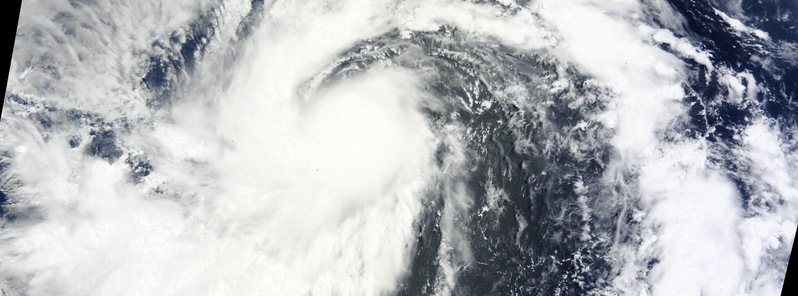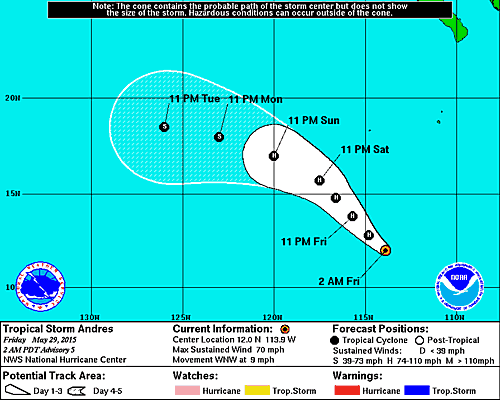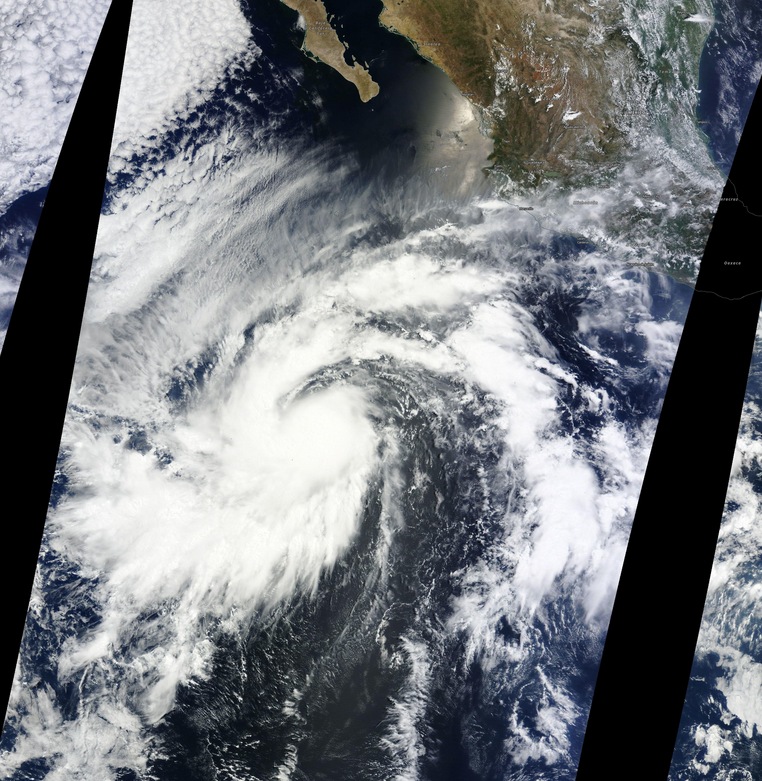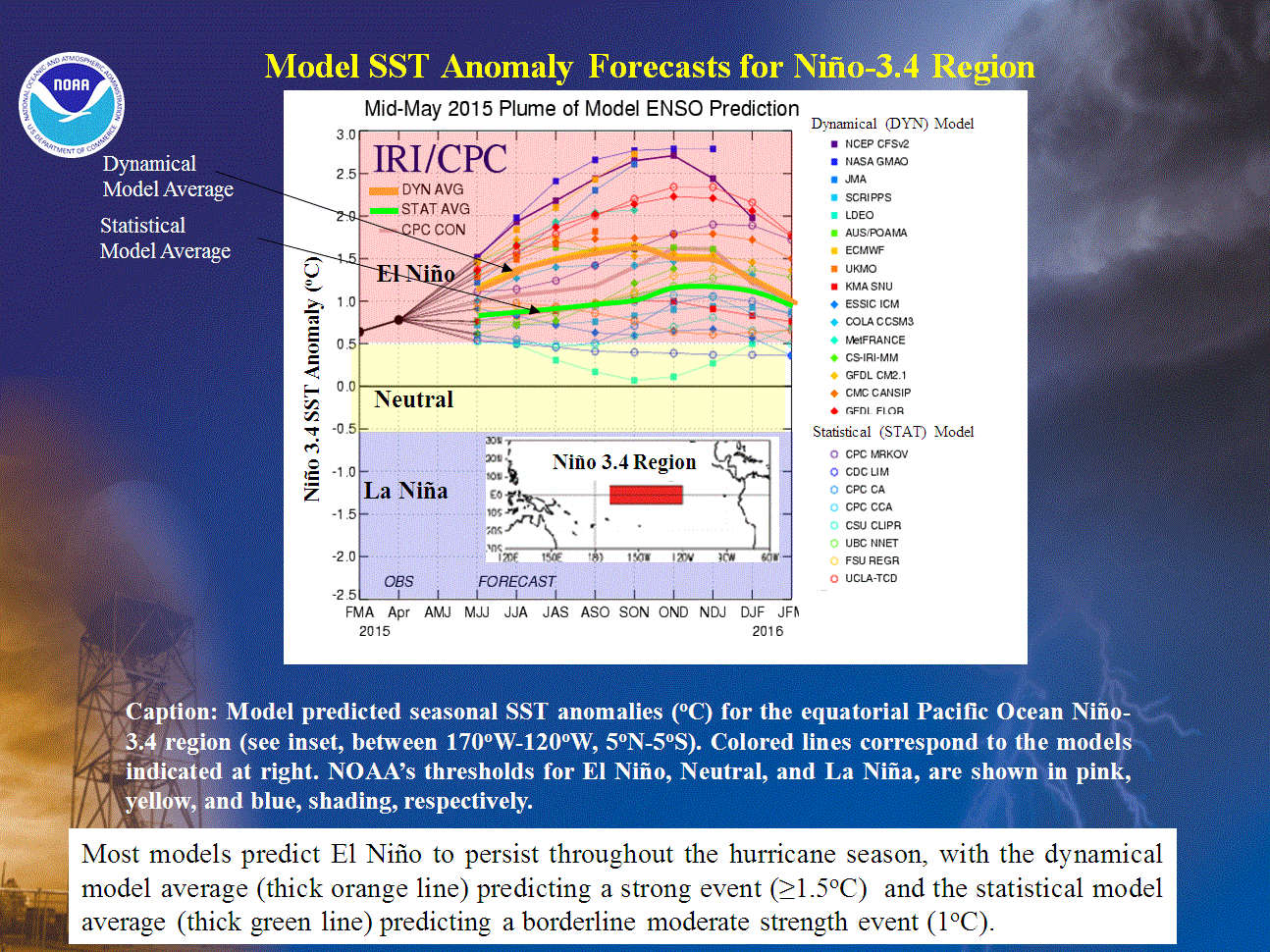Tropical Storm “Andres” forms and becomes first named storm of 2015 eastern Pacific hurricane season

Tropical Storm "Andres" formed on May 28, 2015 about 1 100 km (690 miles) southwest of Manzanillo, Mexico and became the first named storm of the 2015 eastern Pacific hurricane season. The storm is expected to intensify, but stay far off the coast of Mexico.
Andres formed some two weeks after the official start of the 2015 season (May 15 – November 30) which is expected to be above-normal, mainly due to intensifying El Niño conditions.

According to NWS NHC Miami advisory issued at 09:00 UTC on May 29, the center of the storm was located about 1 285 km (795 miles) SSW of the southern tip of Baja California.
At the time, it's maximum sustained winds were 110 km/h (70 mph).
The system was moving to the WNW at 15 km/h (9 mph).
Minimum central pressure was 994 hPa.

Some strengthening is forecast during the next 48 hours, and Andres is expected to become a hurricane later today.
Tropical storm force winds extend outward up to 185 km (115 miles) from the center.

Tropical Storm "Andres" on May 28, 2015. Image credit: NASA Terra/MODIS.
Satellite animations
- Storm-Centered Infrared (GOES 15; NOAA/SSD)
- Storm-Centered Infrared (Aviation Color Enhancement) (GOES 15; NOAA/SSD)
- Storm-Centered Water Vapor (GOES 15; NOAA/SSD)
- Storm-Centered Visible (GOES 15; NOAA/SSD)
- Storm-Centered Visible (Colorized) (GOES 15; NOAA/SSD)
- Storm-Centered Infrared (GOES 15; CIMSS)
- Storm-Centered Enhanced Infrared (GOES 15; CIMSS)
- Storm-Centered Water Vapor (GOES 15; CIMSS)
- Storm-Centered Visible (GOES 15; CIMSS)
- East Pacific Infrared (GOES 15; NOAA/SSD)
- East Pacific (Aviation Color Enhancement) (GOES 15; NOAA/SSD)
- East Pacific Water Vapor (GOES 15; NOAA/SSD)
- East Pacific Visible (GOES 15; NOAA/SSD)
- East Pacific Visible (Colorized) (GOES 15; NOAA/SSD)
Above-normal Eastern Pacific hurricane season expected
NOAA's 2015 Eastern Pacific Hurricane Season Outlook indicates that an above-normal season is most likely, with a 70% chance of an above-normal season, a 25% chance of a near-normal season, and only a 5% chance of a below normal season.
The main climate factor expected to enhance the 2015 eastern Pacific hurricane season is El Niño, which is now present and is predicted to last throughout the hurricane season.
Many models predict this El Niño to strengthen further as the season progresses.

El Niño decreases the vertical wind shear over the eastern tropical Pacific, which favors more and stronger tropical storms and hurricanes. El Niño is already affecting the wind and rainfall patterns across the equatorial and subtropical Pacific Ocean.
Also, the sea surface temperatures patterns that have been associated with decreased hurricane activity in the eastern Pacific since 1995 are not expected during the 2015 season, and are therefore not expected to compete with El Niño's conducive wind patterns.
For the 2015 hurricane season, NOAA estimates a 70% chance of occurrence for each of the following ranges of activity:
- 15 – 22 named storms,
- 7 – 12 hurricanes,
- 5 – 8 major hurricanes,
- An ACE range 110%-190% of the median.
Featured image: Tropical Storm "Andres" on May 28, 2015. Image credit: NASA Terra/MODIS.

Commenting rules and guidelines
We value the thoughts and opinions of our readers and welcome healthy discussions on our website. In order to maintain a respectful and positive community, we ask that all commenters follow these rules.